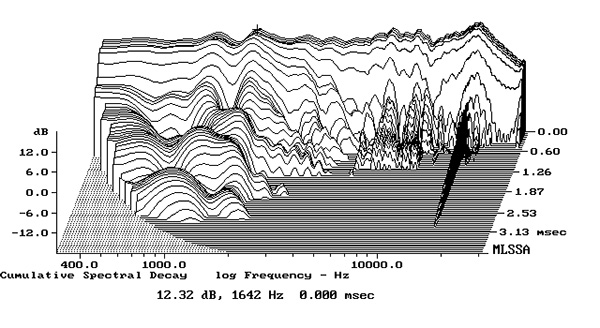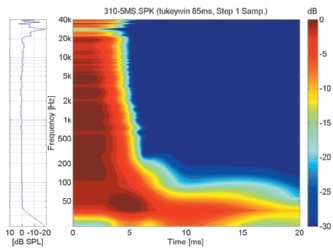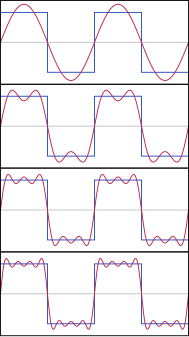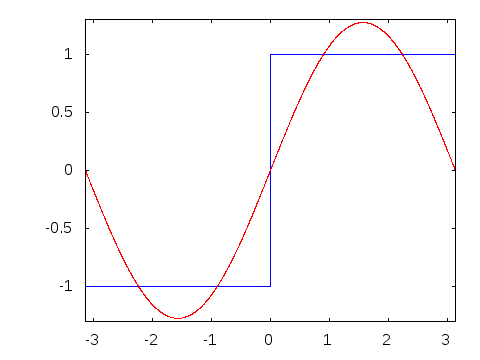Heres your 60hz, wheres the transient?We’re talking about sound in the bass region no? Maybe we can stick to 20hz - 160hz sine waves, the stuff real bass in music is made of. There are transients in that frequency spectrum just as there are in any other portion of the frequency spectrum. Real world rooms reverberate that energy. At the frequencies of the room modes you get standing waves with peaks, nulls and even longer reverberation time than the rest of the bass reverb. All of that smears the perceptual sound of the bass and obscures the transients. You can’t fix that smearing with EQ. EQing peaks is better than nothing. But it does not “eliminate” room modes or much of the ill effects they have on playback. That was the point of my original post and still is. Nothing more.
-
WANTED: Happy members who like to discuss audio and other topics related to our interest. Desire to learn and share knowledge of science required. There are many reviews of audio hardware and expert members to help answer your questions. Click here to have your audio equipment measured for free!
You are using an out of date browser. It may not display this or other websites correctly.
You should upgrade or use an alternative browser.
You should upgrade or use an alternative browser.
Wilson Alexia V - 2023 Stereophile Speaker of the Year ???
- Thread starter MKR
- Start date
Justdafactsmaam
Addicted to Fun and Learning
- Joined
- Nov 13, 2023
- Messages
- 802
- Likes
- 584
If this were a 6khz sine wave then were would the transient be? Change the frequency to anything and what would be the difference? Pointing to a single cycle of any sine wave and asking where is the transient is an absurd question. Reread the very Wikipedia article *you* posted. “Transients do not necessarily directly depend on the frequency of the tone they initiate.”Heres your 60hz, wheres the transient?
That single cycle is all thats left if you take out the harmonics, like with a crossover. That quote means the transient (the fast rise at the start) contains high freqs. not in the tone (the fundamental).If this were a 6khz sine wave then were would the transient be? Change the frequency to anything and what would be the difference? Pointing to a single cycle of any sine wave and asking where is the transient is an absurd question. Reread the very Wikipedia article *you* posted. “Transients do not necessarily directly depend on the frequency of the tone they initiate.”
Go see what a low pass filter does to the rise time (transient) of a square wave, or a kick drum. Ill tell you, it increases the rise time which decreases the transient. The lower the filter freq the slower the rise until your left with only the fundamental. The transients in music are not in the bass. Brick wall a good sub at 80hz, hear any transients? I dont.
Justdafactsmaam
Addicted to Fun and Learning
- Joined
- Nov 13, 2023
- Messages
- 802
- Likes
- 584
A transient is an initial pulse of sound of substantially higher amplitude than the decay that follows. It is not frequency dependent. Again, what do you think you would get if you tested your impulse response and you limited the signal sweep to the bass region? Nothing?That single cycle is all thats left if you take out the harmonics, like with a crossover. That quote means the transient (the fast rise at the start) contains high freqs. not in the tone (the fundamental).
Go see what a low pass filter does to the rise time (transient) of a square wave, or a kick drum. Ill tell you, it increases the rise time which decreases the transient. The lower the filter freq the slower the rise until your left with only the fundamental. The transients in music are not in the bass. Brick wall a good sub at 80hz, hear any transients? I dont.
Last edited:
Justdafactsmaam
Addicted to Fun and Learning
- Joined
- Nov 13, 2023
- Messages
- 802
- Likes
- 584
Also we need to keep the context here. This is about dealing with room modes. No such thing as a single cycle sound wave in a real room. And if you can’t hear any transients below 80 hz in your system that may be the program material. But it may also be indicative of the very issue we are debating in your room.That single cycle is all thats left if you take out the harmonics, like with a crossover. That quote means the transient (the fast rise at the start) contains high freqs. not in the tone (the fundamental).
Go see what a low pass filter does to the rise time (transient) of a square wave, or a kick drum. I’ll tell you, it increases the rise time which decreases the transient. The lower the filter freq the slower the rise until you’re left with only the fundamental. The transients in music are not in the bass. Brick wall a good sub at 80hz, hear any transients? I dont.
Justdafactsmaam
Addicted to Fun and Learning
- Joined
- Nov 13, 2023
- Messages
- 802
- Likes
- 584
Seriously? Thunder from close range? Explosions? Bass drum? Tympani drum? None of those have a sudden rise and decay in the bass? Well, I suppose they won’t if you rely on EQ to fix room modes. I’m curious, have you ever looked at a waterfall plot of a speaker measured from the listening position in a room? If so what do think you are looking at from 20 hz - 80 hz?I don't hear any transients below 80hz because there aren't any, this is audio 101.
Last edited:
Of course not. The steep part of a rise or decay is exclusively high frequency content, not bass.Seriously? Thunder from close range? Explosions? Bass drum? Tympanum drum? None of those have a sudden rise and decay in the bass?
Justdafactsmaam
Addicted to Fun and Learning
- Joined
- Nov 13, 2023
- Messages
- 802
- Likes
- 584
Have you ever looked at a waterfall plot? What do you think you are looking at from 20 hz - 80 hz ? Do you see a slow rise in the amplitude before the decay? Or do you see a near instantaneous peak? You really think there is a slow rise in the low frequency SPLs when you hear a bomb explode? The very first cycle is the highest in amplitude from any percussive sourced sound. The “rise” is immediate. *That* is the leading edge of a transient.Of course not. The steep part of a rise or decay is exclusively high frequency content, not bass.
Anton D
Addicted to Fun and Learning
- Joined
- Mar 17, 2021
- Messages
- 953
- Likes
- 1,095
Great subject.Seriously? Thunder from close range? Explosions? Bass drum? Tympanum drum? None of those have a sudden rise and decay in the bass? Well, I suppose they won’t if you rely on EQ to fix room modes. I’m curious, have you ever looked at a waterfall plot of a speaker measured from the listening position in a room? If so what do think you are looking at from 20 hz - 80 hz?
Thanks for these posts.
The waterfall plots I know all show only the decay, not the rise. And the decay on the low frequencies is much longer than elsewhere.Have you ever looked at a waterfall plot? What do you think you are looking at from 20 hz - 80 hz ? Do you see a slow rise in the amplitude before the decay? Or do you see a near instantaneous peak?
Edit: here are typical examples from Stereophile (Estelon Aura) and Sound & Recording (Neumann KH310, sealed box):


Yes! It's math, Fourier series:You really think there is a slow rise in the low frequency SPLs when you hear a bomb explode?
The first four partial sums of the Fourier series for a square wave. As more harmonics are added, the partial sums converge to (become more and more like) the square wave.

Yes, and this leading edge of the rise consists of high frequencies. The spectrum of percussions is very wide and ranges from almost DC up to high frequencies.The very first cycle is the highest in amplitude from any percussive sourced sound. The “rise” is immediate. *That* is the leading edge of a transient.
See this example from Wikipedia, which starts with a low frequency sinus (fundamental) with a slow rise, and then adds more and more harmonics with rising frequency. The more harmonic are added the steeper gets the rise:

If you have access to a sub then do this experiment: play percussive sounds with what you'd call a fast bass. Then disconnect the satellites and listen to the sub only, and tell me whether the percussion still sounds fast.
Last edited:
Justdafactsmaam
Addicted to Fun and Learning
- Joined
- Nov 13, 2023
- Messages
- 802
- Likes
- 584
The rise is instantaneous. The measurements use a sweep to calculate a pure full frequency pulse signal. What you are looking at is the impulse response along the frequency spectrum. It is a calculation of the decay with a pure transient signal. The reason a sweep is used instead of an actual pulse is because a pulse loud enough to effectively do the measurement would blow out virtually and speaker system and cause ear damage. Now back to my original point. When you have a major peak in the bass due to a room mode you also have major reverb. The reverb is what creates the peak. It also creates audible smearing. If you EQ the signal to compensate for the standing wave the standing wave is still there and the signal is now buried in the reverb both in amplitude and time. You can’t eliminate a room mode peak with EQ. It’s better than nothing but far from a cure.The waterfall plots I know all show only the decay, not the rise. And the decay on the low frequencies is much longer than elsewhere.
Edit: here are typical examples from Stereophile (Estelon Aura) and Sound & Recording (Neumann KH310, sealed box):


Yes! It's math, Fourier series:
The first four partial sums of the Fourier series for a square wave. As more harmonics are added, the partial sums converge to (become more and more like) the square wave.

Yes, and this leading edge of the rise consists of high frequencies. The spectrum of percussions is very wide and ranges from almost DC up to high frequencies.
See this example from Wikipedia, which starts with a low frequency sinus (fundamental) with a slow rise, and then adds more and more harmonics with rising frequency. The more harmonic are added the steeper gets the rise:

If you have access to a sub then do this experiment: play percussive sounds with what you'd call a fast bass. Then disconnect the satellites and listen to the sub only, and tell me whether the percussion still sounds fast.
Adis
Member
- Joined
- Mar 4, 2021
- Messages
- 67
- Likes
- 45
How instantaneous? Is it quicker than 1/22050th of a second? Can't catch that at 44.1 kHz SR - too high of a frequency.The rise is instantaneous. The measurements use a sweep to calculate a pure full frequency pulse signal. What you are looking at is the impulse response along the frequency spectrum. It is a calculation of the decay with a pure transient signal. The reason a sweep is used instead of an actual pulse is because a pulse loud enough to effectively do the measurement would blow out virtually and speaker system and cause ear damage. Now back to my original point. When you have a major peak in the bass due to a room mode you also have major reverb. The reverb is what creates the peak. It also creates audible smearing. If you EQ the signal to compensate for the standing wave the standing wave is still there and the signal is now buried in the reverb both in amplitude and time. You can’t eliminate a room mode peak with EQ. It’s better than nothing but far from a cure.
Justdafactsmaam
Addicted to Fun and Learning
- Joined
- Nov 13, 2023
- Messages
- 802
- Likes
- 584
As for the “slow rise” of a bass note. You do realize that a 20hz cycle takes all of 5 milliseconds right? A real world transient attack in music ain’t over in less than 5 milliseconds. The reverb from a room mode can last for a full second. The very best in room decay times cross the full spectrum are maybe just under 100 milliseconds.The waterfall plots I know all show only the decay, not the rise. And the decay on the low frequencies is much longer than elsewhere.
Edit: here are typical examples from Stereophile (Estelon Aura) and Sound & Recording (Neumann KH310, sealed box):


Yes! It's math, Fourier series:
The first four partial sums of the Fourier series for a square wave. As more harmonics are added, the partial sums converge to (become more and more like) the square wave.

Yes, and this leading edge of the rise consists of high frequencies. The spectrum of percussions is very wide and ranges from almost DC up to high frequencies.
See this example from Wikipedia, which starts with a low frequency sinus (fundamental) with a slow rise, and then adds more and more harmonics with rising frequency. The more harmonic are added the steeper gets the rise:

If you have access to a sub then do this experiment: play percussive sounds with what you'd call a fast bass. Then disconnect the satellites and listen to the sub only, and tell me whether the percussion still sounds fast.
as for “slow rise times” in the bass it’s probably good to keep in mind that a single 20 hz pulse is 5 milliseconds. That’s a transient by any meaningful definition of transients in the sound of music.The waterfall plots I know all show only the decay, not the rise. And the decay on the low frequencies is much longer than elsewhere.
Edit: here are typical examples from Stereophile (Estelon Aura) and Sound & Recording (Neumann KH310, sealed box):


Yes! It's math, Fourier series:
The first four partial sums of the Fourier series for a square wave. As more harmonics are added, the partial sums converge to (become more and more like) the square wave.

Yes, and this leading edge of the rise consists of high frequencies. The spectrum of percussions is very wide and ranges from almost DC up to high frequencies.
See this example from Wikipedia, which starts with a low frequency sinus (fundamental) with a slow rise, and then adds more and more harmonics with rising frequency. The more harmonic are added the steeper gets the rise:

If you have access to a sub then do this experiment: play percussive sounds with what you'd call a fast bass. Then disconnect the satellites and listen to the sub only, and tell me whether the percussion still sounds fast.
Last edited:
Justdafactsmaam
Addicted to Fun and Learning
- Joined
- Nov 13, 2023
- Messages
- 802
- Likes
- 584
5 milliseconds for 20 hz. You all do understand that this is about transients in actual music right? And we are talking about the effects of a room mode peak on audio playback in a real world room yeah?How instantaneous? Is it quicker than 1/22050th of a second? Can't catch that at 44.1 kHz SR - too high of a frequency.
LOL
Check your math. AFAIK, 1,000 divided by 20 isn’t 5.You do realize that a 20hz cycle takes all of 5 milliseconds right?
Justdafactsmaam
Addicted to Fun and Learning
- Joined
- Nov 13, 2023
- Messages
- 802
- Likes
- 584
You know what. Keep on trying to fix room modes with EQ. Enjoy your smeared bass. It’s no wonder Ethan Winer left this forum in disgust.Justdafacts, ever studied Fourier analysis? Just wondering.
You know what. Keep on trying to fix room modes with EQ. Enjoy your smeared bass. It’s no wonder Ethan Winer left this forum in disgust.
Hmm, I don't think that answered my question.
Let me try this: What is the fourier transform of a single cycle of a 40Hz sine wave?
Similar threads
- Replies
- 36
- Views
- 3K
- Replies
- 383
- Views
- 36K
- Replies
- 125
- Views
- 26K
- Replies
- 46
- Views
- 4K
- Replies
- 524
- Views
- 25K
